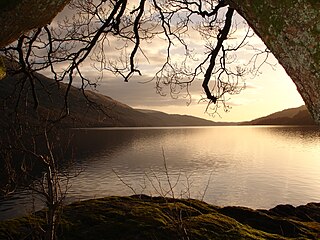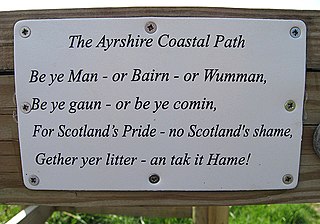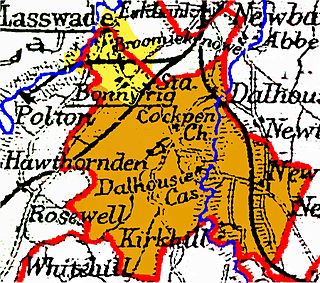
"The Hundred Pipers" is a Scottish song and jig attributed to Carolina Nairne, Lady Nairne and popularised from 1852 onwards. It takes as its themes events during and after the Jacobite Rising of 1745.

"The Hundred Pipers" is a Scottish song and jig attributed to Carolina Nairne, Lady Nairne and popularised from 1852 onwards. It takes as its themes events during and after the Jacobite Rising of 1745.
The song commemorates the surrender of the town of Carlisle to Prince Charles Edward Stuart, on 18 November 1745, when he invaded England, at the head of a mixed army of Highlanders and Lowlanders, after his victory at Prestonpans. He "entered Carlisle on a white horse, with a hundred pipers playing before him, whose shrill music was not calculated to inspire the citizens with confidence in their grotesque conquerors", according to Burtons History of Scotland. [1]
The episode, recorded in the fourth stanza, of two thousand Highlanders swimming the River Esk, when in flood, on the occasion of the capture of Carlise, is not quite correct. It refers to a later period, when Prince Charles made his disastrous retreat from Derby, and Carlisle had been retaken. It was Scots, and not "fell English ground" which they reached on that occasion. But Lady Nairne, by combining the two events, produced a very spirited and successful ballad, which takes a high place among later Jacobite songs. [1]
"The Hundred Pipers" is attributed to Carolina Nairne, Lady Nairne, a prolific songwriter of the period descending from a Jacobite family. The verses appears in the second edition of her Lays from Strathern (1846). [1]
"The Hundred Pipers" does not seem to have been printed as a song until about 1852, when it was issued at Edinburgh in sheet form, with the music arranged by Elizabeth Rainforth. Rainforth, a soprano singer, appears to have been responsible for introducing it to the public, some five or more years after Nairne's death. Rainforth lived in Edinburgh from 1851 [2] or 1852 to 1856, [3] and contemporary publications post reviews of her performance of the song in the capital; [4] and she published the song with her own (and the now standard) musical arrangement in 1852. [5] [1] [6]
The song does not date from the Jacobite period, as is the case with many others now considered in the "classic canon of Jacobite songs", most of which were songs "composed in the late eighteenth and nineteenth centuries, but were passed off as contemporary products of the Jacobite risings." [7]
The tune has not been satisfactorily traced, and though it is indexed in the Lays as "Hundred Pipers", no such air is known to exist previous to the date of Lady Nairne's song. [1]
In 1998, Scottish singer Isla St Clair recorded a version of "The Hundred Pipers" sung in the old style, for her album When the Pipers Play. This version was also included in the film When the Pipers Play, aired by PBS Television in the United States.
In 1958 Lord Rockingham's XI had a Number One UK hit with "Hoots Mon!", a mainly instrumental rock 'n' roll tune (with Scots-inspired interjections including "Hoots mon! There's a moose... loose... aboot this hoose!") based on the melody of "The Hundred Pipers".
These lyrics are in Scots.
Chorus:

Carolina Oliphant, Lady Nairne – also known as Carolina Baroness Nairn in the peerage of Scotland and Baroness Keith in that of the United Kingdom – was a Scottish songwriter. Many of her songs, such as, "Will ye no' come back again?", "Charlie is my Darling", "The Rowan Tree" and "Wi' a Hundred Pipers' remain popular today, almost two hundred years after they were written. One of her songs, "Caller Herrin'", was sung at the 2021 commemoration of the 1881 Eyemouth disaster. She usually set her words to traditional Scottish folk melodies, but sometimes contributed her own music.

"Sir Patrick Spens" is one of the most popular of the Child Ballads, and is of Scottish origin. It is a maritime ballad about a disaster at sea.
Pibroch, piobaireachd or ceòl mòr is an art music genre associated primarily with the Scottish Highlands that is characterised by extended compositions with a melodic theme and elaborate formal variations. Strictly meaning "piping" in Scottish Gaelic, piobaireachd has for some four centuries been music of the Great Highland Bagpipe. Music of a similar nature, pre-dating the adoption of the Highland pipes, has historically been played on the wire-strung Gaelic harp and later on the Scottish fiddle, and this form is undergoing a revival.
"Highland Laddie", also known as "Hielan' Laddie", is the name of a Scottish popular folk tune "If Thou'lt Play Me Fair Play", but as with many old melodies various sets of words can be sung to it, of which Robert Burns's poem "Highland Laddie" is probably the best known. "If Thou'lt Play Me Fair Play" has been reworked several times since Burns set down his words, Donkey Riding being one variant.
"The Elfin Knight" is a traditional Scottish folk ballad of which there are many versions, all dealing with supernatural occurrences, and the commission to perform impossible tasks. The ballad has been collected in different parts of England, Scotland, Ireland, the US, and Canada. As is the case with most traditional folk songs, there have been countless completely different versions recorded of the same ballad. The first broadside version was printed before 1674, and the roots of the song may be considerably older.
The Bonnie Lass o' Fyvie is a Scottish folk song about a thwarted romance between a soldier and a girl. Like many folk songs, the authorship is unattributed, there is no strict version of the lyrics, and it is often referred to by its opening line "There once was a troop o' Irish dragoons". The song is also known by a variety of other names, the most common of them being "Peggy-O", "Fennario", and "The Maid of Fife".

"The Bonnie Banks o' Loch Lomond", or "Loch Lomond" for short, is a Scottish song. The song prominently features Loch Lomond, the largest Scottish loch, located between the council areas of West Dunbartonshire, Stirling and Argyll and Bute. In Scots, "bonnie" means "attractive", "beloved", or "dear".
A Scotticism is a phrase or word which is characteristic of dialects of the Scots language.
Southern Scots is the dialect of Scots spoken in the Scottish Borders counties of mid and east Dumfriesshire, Roxburghshire and Selkirkshire, with the notable exception of Berwickshire and Peeblesshire, which are, like Edinburgh, part of the SE Central Scots dialect area. It may also be known as Border Scots, the Border tongue or by the names of the towns inside the South Scots area, for example Teri in Hawick from the phrase Teribus ye teri odin. Towns where South Scots dialects are spoken include Earlston, Galashiels (Gala or Galae), Hawick, Jedburgh (Jethart), Kelso (Kelsae), Langholm, Lockerbie, Newcastleton (Copshaw or Copshawholm), St. Boswells (Bosells) and Selkirk.
"Coulter's Candy", also known as "Ally Bally" or "Ally Bally Bee, is a Scots folk song.
"The Lochmaben Harper" or "The Blind Harper" is a traditional British Folk ballad and is one of the ballads collected by Francis Child in The English and Scottish Popular Ballads (1882–1898).
"Bonnie Charlie", also commonly known as "Will ye no come back again?", is a Scots poem by Carolina Oliphant, set to a traditional Scottish folk tune. As in several of the author's poems, its theme is the aftermath of the Jacobite Rising of 1745, which ended at the Battle of Culloden. Written well after the events it commemorates, it is not a genuine Jacobite song, like many other songs that were "composed in the late eighteenth and nineteenth centuries, but ... passed off as contemporary products of the Jacobite risings."

Modern Scots comprises the varieties of Scots traditionally spoken in Lowland Scotland and parts of Ulster, from 1700.
Cam ye o'er frae France? is a Scots folk song from the time of the Jacobite rebellions of the 18th century. It satirises the marital problems of the Hanoverian George I.

"Wha'll be King but Charlie?" also known as The News from Moidart, is a song about Bonnie Prince Charlie, sung to the tune of 'Tidy Woman', a traditional Irish jig the date of which is unclear but the tune was well known by 1745. The lyrics were written by Caroline Nairne. Because Nairne published anonymously, the authorship of this and her other poems and lyrics was once unclear, however, late in her life Nairne identified herself and modern scholars accept that these lyrics are hers. Carolina, Baroness Nairne was a Jacobite from a Jacobite family living at a time when the last remnants of political Jacobitism were fading as Scotland entered a period of Romantic nationalism and literary romanticism. Bonnie Prince Charlie stayed in the house where Caroline Nairne was born and reared when fleeing British capture after losing the Battle of Culloden.
Events from the year 1846 in Scotland.

Cockpen is a parish in Midlothian, Scotland, containing at its north-west corner the town of Bonnyrigg, which lies two miles (3.2 km) south-west of Dalkeith. It is bounded on the west and north by the parish of Lasswade, on the east, by Newbattle and on the south by Carrington. It extends about three miles (4.8 km) from north to south and its greatest breadth is about 2+1⁄2 miles (4.0 km).

Elizabeth Rainforth (1814–1877), was a British soprano opera and concert singer, and music arranger of the 19th century.

The Laird o' Cockpen is a song written by Carolina Oliphant, Lady Nairne (1766–1845), which she contributed anonymously to The Scottish Minstrel, a six-volume collection of traditional Scottish songs published from 1821 to 1824. Much of the Scottish poetry in Carolina's time was concerned with writing genteel verses for somewhat bawdier earlier songs, and The Laird o' Cockpen is no exception, being set to the music of "O when she cam' ben she bobbit".

The recorded source of the children's story The Marriage of Robin Redbreast and the Wren is Isabella Burns, later Mrs Isabella Burns Begg, the youngest sister of Robert Burns. Isabella recalled that her brother, Robert Burns, was the author and that he was in the habit of telling the tale to entertain the younger members of his family at Lochlea Farm, such as herself, Annabella, John and William. This nursery tale was first published by Dr Robert Chambers in his "Popular Rhymes of Scotland".